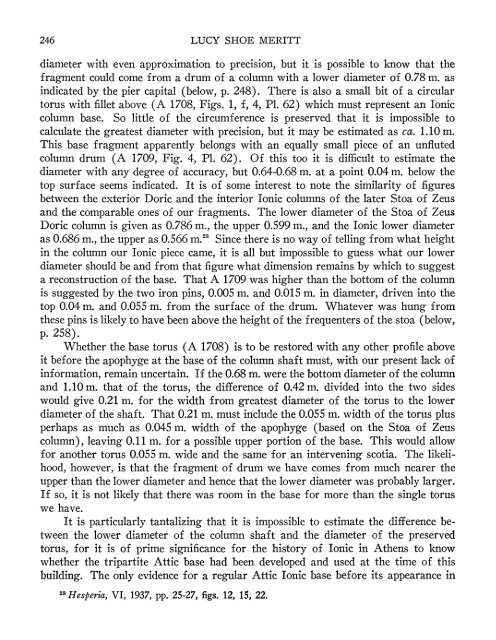the stoa poikile - The American School of Classical Studies at Athens
the stoa poikile - The American School of Classical Studies at Athens
the stoa poikile - The American School of Classical Studies at Athens
Create successful ePaper yourself
Turn your PDF publications into a flip-book with our unique Google optimized e-Paper software.
246 LUCY SHOE MERITT<br />
diameter with even approxim<strong>at</strong>ion to precision, but it is possible to know th<strong>at</strong> <strong>the</strong><br />
fragment could come from a drum <strong>of</strong> a column with a lower diameter <strong>of</strong> 0.78 m. as<br />
indic<strong>at</strong>ed by <strong>the</strong> pier capital (below, p. 248). <strong>The</strong>re is also a small bit <strong>of</strong> a circular<br />
torus with fillet above (A 1708, Figs. 1, f, 4, P1. 62) which must represent an Ionic<br />
column base. So little <strong>of</strong> <strong>the</strong> circumference is preserved th<strong>at</strong> it is impossible to<br />
calcul<strong>at</strong>e <strong>the</strong> gre<strong>at</strong>est diameter with precision, but it may be estim<strong>at</strong>ed as ca. 1.10 m.<br />
This base fragment apparently belongs with an equally small piece <strong>of</strong> an unfluted<br />
column drum (A 1709, Fig. 4, P1. 62). Of this too it is difficult to estim<strong>at</strong>e <strong>the</strong><br />
diameter with any degree <strong>of</strong> accuracy, but 0.64-0.68 m. <strong>at</strong> a point 0.04 m. below <strong>the</strong><br />
top surface seems indic<strong>at</strong>ed. It is <strong>of</strong> some interest to note <strong>the</strong> similarity <strong>of</strong> figures<br />
between <strong>the</strong> exterior Doric and <strong>the</strong> interior Ionic columns <strong>of</strong> <strong>the</strong> l<strong>at</strong>er Stoa <strong>of</strong> Zeus<br />
and <strong>the</strong> comparable ones <strong>of</strong> our fragments. <strong>The</strong> lower diameter <strong>of</strong> <strong>the</strong> Stoa <strong>of</strong> Zeus<br />
Doric column is given as 0.786 m., <strong>the</strong> upper 0.599 m., and <strong>the</strong> Ionic lower diameter<br />
as 0.686 m., <strong>the</strong> upper as 0.566 m.23 Since <strong>the</strong>re is no way <strong>of</strong> telling from wh<strong>at</strong> height<br />
in <strong>the</strong> column our Ionic piece came, it is all but impossible to guess wh<strong>at</strong> our lower<br />
diameter should be and from th<strong>at</strong> figure wh<strong>at</strong> dimension remains by which to suggest<br />
a reconstruction <strong>of</strong> <strong>the</strong> base. Th<strong>at</strong> A 1709 was higher than <strong>the</strong> bottom <strong>of</strong> <strong>the</strong> column<br />
is suggested by <strong>the</strong> two iron pins, 0.005 m. and 0.015 m. in diameter, driven into <strong>the</strong><br />
top 0.04 m. and 0.055 m. from <strong>the</strong> surface <strong>of</strong> <strong>the</strong> drum. Wh<strong>at</strong>ever was hung from<br />
<strong>the</strong>se pins is likely to have been above <strong>the</strong> height <strong>of</strong> <strong>the</strong> frequenters <strong>of</strong> <strong>the</strong> <strong>stoa</strong> (below,<br />
p. 258).<br />
Whe<strong>the</strong>r <strong>the</strong> base torus (A 1708) is to be restored with any o<strong>the</strong>r pr<strong>of</strong>ile above<br />
it before <strong>the</strong> apophyge <strong>at</strong> <strong>the</strong> base <strong>of</strong> <strong>the</strong> column shaft must, with our present lack <strong>of</strong><br />
inform<strong>at</strong>ion, remain uncertain. If <strong>the</strong> 0.68 m. were <strong>the</strong> bottom diameter <strong>of</strong> <strong>the</strong> column<br />
and 1.10 m. th<strong>at</strong> <strong>of</strong> <strong>the</strong> torus, <strong>the</strong> difference <strong>of</strong> 0.42 m. divided into <strong>the</strong> two sides<br />
would give 0.21 m. for <strong>the</strong> width from gre<strong>at</strong>est diameter <strong>of</strong> <strong>the</strong> torus to <strong>the</strong> lower<br />
diameter <strong>of</strong> <strong>the</strong> shaft. Th<strong>at</strong> 0.21 m. must include <strong>the</strong> 0.055 m. width <strong>of</strong> <strong>the</strong> torus plus<br />
perhaps as much as 0.045 m. width <strong>of</strong> <strong>the</strong> apophyge (based on <strong>the</strong> Stoa <strong>of</strong> Zeus<br />
column), leaving 0.11 m. for a possible upper portion <strong>of</strong> <strong>the</strong> base. This would allow<br />
for ano<strong>the</strong>r torus 0.055 m. wide and <strong>the</strong> same for an intervening scotia. <strong>The</strong> likeli-<br />
hood, however, is th<strong>at</strong> <strong>the</strong> fragment <strong>of</strong> drum we have comes from much nearer <strong>the</strong><br />
upper than <strong>the</strong> lower diameter and hence th<strong>at</strong> <strong>the</strong> lower diameter was probably larger.<br />
If so, it is not likely th<strong>at</strong> <strong>the</strong>re was room in <strong>the</strong> base for more than <strong>the</strong> single torus<br />
we have.<br />
It is particularly tantalizing th<strong>at</strong> it is impossible to estim<strong>at</strong>e <strong>the</strong> difference be-<br />
tween <strong>the</strong> lower diameter <strong>of</strong> <strong>the</strong> column shaft and <strong>the</strong> diameter <strong>of</strong> <strong>the</strong> preserved<br />
torus, for it is <strong>of</strong> prime significance for <strong>the</strong> history <strong>of</strong> Ionic in A<strong>the</strong>ns to know<br />
whe<strong>the</strong>r <strong>the</strong> tripartite Attic base had been developed and used <strong>at</strong> <strong>the</strong> time <strong>of</strong> this<br />
building. <strong>The</strong> only evidence for a regular Attic Ionic base before its appearance in<br />
23Hesperia, VI, 1937, pp. 25-27, figs. 12, 15, 22.

















